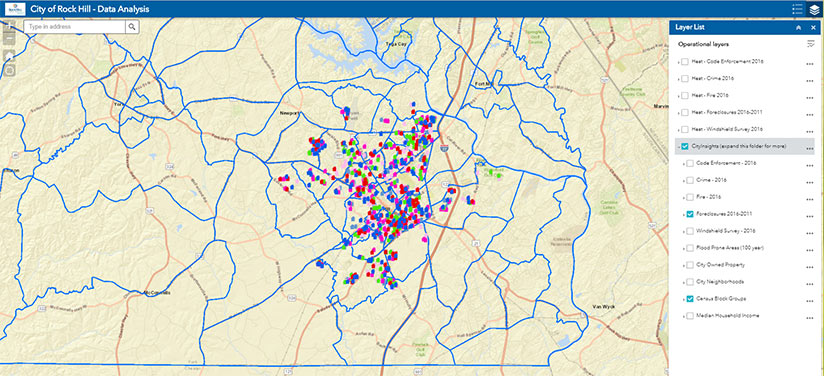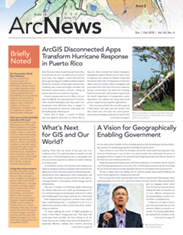In the City of Rock Hill, South Carolina, some datasets have traditionally been kept in silos. Only police used and analyzed crime data. Code enforcement data was the responsibility of the housing and neighborhood services department. And information about fires was the sole domain of the fire department.
In the summer of 2016, the city’s management team embarked on a project to synthesize various datasets and information using GIS. The team requested assistance from the information technology services (ITS) department’s GIS division to evaluate and better understand some of the city’s datasets. Specifically, the team was looking to get a handle on the geography of public safety and code violation events. It wanted to analyze data together and use mapping to visually demonstrate patterns and gain a holistic view of the community.
The ITS/GIS division employed several ArcGIS solutions to help unearth the full story of public safety in Rock Hill. The result? The management team requested that the city council implement new policies for specific neighborhoods.
“Ideally, we would have enough money to solve all the problems of our neighborhoods,” said Rock Hill mayor John Gettys. “But realistically, this gives us a tool by which we can justly focus our resources on the areas with the highest needs.”
Finding Correlations Among Data
To begin the project, the ITS/GIS division obtained data that is available to most municipalities. The team acquired a complete crime dataset from the city’s crime analyst and a list from the fire department with all the information about local fire incidents. ITS/GIS staff gleaned foreclosure data from the county’s website, which showed all the parcels that were on the docket for foreclosure. They pulled data from the city’s cloud-based Mobile311 site to find potential code violations, such as overgrown grass or abandoned vehicles. They also got income and demographic data from the US Census Bureau.

GIS analysts then used ArcGIS Desktop to geocode the data against the city’s street layer and join all the datasets to the city’s address and parcel layers. The Polygon to Point, Frequency, Spatial Join, and other overlay tools in ArcToolbox were particularly helpful for this project.
Next, the city manager’s office did a regression analysis in Microsoft Excel using the data from ArcGIS Desktop to find any correlations among variables. One of the more interesting datasets was a polygon layer built using census block groups that showed income and demographic data along with frequency counts for specific incidents, such as foreclosures by year, violent and property crime, fires, and code enforcement issues.
For the first time, the team saw that a large number of foreclosures were in more affluent parts of town. Nobody would have guessed this without seeing the data on a map. Staff had not previously targeted these areas to receive foreclosure prevention information, but with this new picture emerging, that was going to change.
An Easy-to-Use, Interactive Visualization Tool
To share all this information with city leaders and officials in a clear and understandable way, the ITS/GIS division created a web app. GIS analysts used ArcGIS Server to publish the data as a service before feeding it to a web map in ArcGIS Online. Employing Web AppBuilder for ArcGIS, the team built a web map app that contained interactive heat maps of the various incidents.
The final web map app was presented to both the management team and the city council, and the reception was extremely positive. Decision-makers finally had a tool that was easy to use and presented data in a logical way.
“From a citywide perspective, it was an enlightening process to have an interactive map by which we could see the greatest issues negatively impacting our local neighborhoods,” said Gettys.
It turned out, there was indeed a relationship between incidents like fires and boarded-up homes, or residents who make frequent calls requesting medical assistance and code enforcement issues on their properties. Neighborhoods with the highest number of correlated variables clearly needed attention from the city.
Quantifying Long-Held Suspicions
The neighborhood at the top of that list was Catawba Terrace, an old, once-prosperous area of Rock Hill that had been in decline for a few decades.
Staff verified that several of the issues in this neighborhood were related to the fact that it consisted mostly of rental units. More than 80 percent of houses in Catawba Terrace were being rented out, and rental units accounted for 83 percent of code enforcement violations in the area.
This gives us a tool by which we can justly focus our resources on the areas with the highest needs.
The city had long suspected that these rental properties were a key contributor to why this neighborhood was in disrepair, but it never had the data to back that up. Finally, city staff could see that the high concentration of unregulated rental housing in Catawba Terrace was constraining people to live in substandard housing that posed safety risks. What’s more, over a third of the rented properties were owned by a handful of landlords.
“The story that we were able to tell using the compilation of the various datasets and their correlations provided us with a strong foundation to make a fact-based case for regulating rental properties within a particularly challenged neighborhood,” said Jennifer Wilford, the director of Rock Hill’s housing and neighborhood services department. “It allowed us to quantify long-held suspicions and shape policy.”
The City of Rock Hill began hosting community meetings to address Catawba Terrace residents’ concerns regarding broken streetlights, dilapidated sidewalks, crime, and more. Concurrent with these efforts, the city council approved a pilot ordinance wherein the housing and neighborhood services department inspects rental properties prior to new tenants moving in. Inspectors look into basic safety issues: Does the water work? Can windows be opened for ventilation? Are all mechanical and electrical systems properly installed and maintained?

Although landlords initially expressed misgivings about these inspections, the city has worked tirelessly to develop their buy-in by making the process quick and easy. Now, rental units in Catawba Terrace are in better condition than they were before, and landlords have access to a rental database that gives them information on potential tenants, like whether they caused damages at their previous residences or if there were any issues with police.
Catawba Terrace residents are now taking more pride in their neighborhood. Civic organizations and churches in the area are rehabilitating run-down houses, and incidents of crime, fire, and code violations have been steadily decreasing.
The Power of Collaboration
GIS allowed decision-makers in Rock Hill to not only integrate multiple data sources but also visualize their relationships via maps. This gave staff the ability to make data-driven decisions and create a workable program that has a positive impact on neighborhoods such as Catawba Terrace.
“By using the power of ArcGIS to take disparities in data and combine them into an easily understood cross-referencing system, it tears down the natural silos in an organization and begins to show the power of collaboration to improve decision-making,” said Vince Simonowicz, the city’s chief information officer. “As a result, GIS is quickly becoming the lifeblood of a progressive and growing municipality.”
For more information, contact GIS manager Shawn Carson at shawn.carson@cityofrockhill.com or 803-329-8723 or strategy and performance manager Lisa Brown at lisa.brown@cityofrockhill.com or 803-326-3814.



